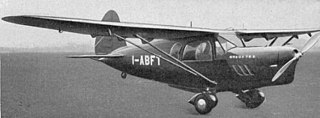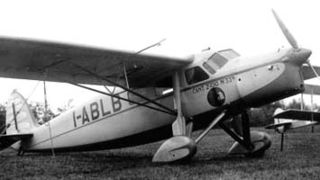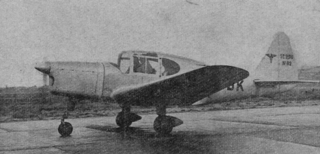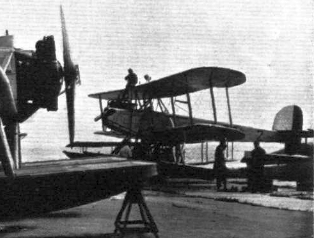
The Breda Ba.79S was a single-engine four-seat high-wing private aircraft built in Italy in the late 1930s. Only a few were produced.
The Farman F.280 was a three engine, cantilever wing monoplane designed in France as a mail carrier in the early 1930s. Underpowered and slow, only two were built and briefly used.

The CANT Z.1010 was a single engine, five seat Italian passenger aircraft flown in the mid-1930s. Only one was built.
The CNA Eta was a single engine Italian light aircraft, flown in the mid-1930s, that set one and two seat world records as both a landplane and a seaplane. Only one or two were built.

The Starck AS-80 Holiday is a conventional two-seat, single-engine high-wing monoplane designed and built in France around 1950. It was sold in kit form but only a few were completed.
The Starck AS-57 is a single engine low wing monoplane seating two in side-by-side configuration. It was designed and built in France just after World War II; only ten were produced, one of which was still active in 2012.

The Sud-Est SE-2300 or S.N.C.A.S.E. SE-2300 was a two/three seat low wing, single engine touring aircraft, built just after World War II in France. The SE-2310 was a tricycle undercarriage variant. Neither type went into production.
The Rolandas Kalinauskas RK-5 Ruth, also called the Viltis, is a Lithuanian light aircraft, designed and produced by Rolandas Kalinauskas, of Prienai. The aircraft is supplied as a complete ready-to-fly-aircraft.

The Koolhoven F.K.47 was a 1930s one-off two seat biplane designed and built in the Netherlands for an individual customer as a sport and touring aircraft.

The Koolhoven F.K.54 was a Dutch single-engine, three-seat touring aircraft with a retractable undercarriage. It flew shortly before the start of World War II and its development was abandoned after its first flight as attention turned to military aircraft.

The LFG V 60 was a small, single engine, tandem seat floatplane training aircraft, designed and built in Germany in the mid-1920s. About five were constructed.
The Ruhrtaler Ru.3 was a German advanced single-seat trainer designed to take pilots to combat standards. Initial flying tests showed promise but the owner of Ruhrtaler cancelled all aeronautical activity after his son was killed whilst demonstrating the Ru.3 to the Air Ministry.

The Müller G.M.G. II was a German single engine, tandem seat sports monoplane from 1928. Its high wing was unusually mounted.
The SNCASO SO.3050 was designed and built in France towards the end of World War II. Only one was completed and that was soon abandoned.

The Les Mureaux 3 C.2 and Les Mureaux 4 C.2 were French two seat, parasol winged fighters, flown in 1927-8, which differed only in their engines. They were developed into near identical army co-operation types, the ANF Les Mureaux 130 A.2 and ANF Les Mureaux 131 A.2, in 1929-31.
The S.E.C.A.T.-VI La Mouette or S.E.C.A.T. 60T La Mouette was a French two seat tourer built shortly before the outbreak of World War II.

The SFCA Maillet 20 was a French three seat tourer built in 1935. The Armée de l'Air ordered 30 for training and liaison and several were raced. The aircraft was developed through 1935 via cockpit layout and canopy changes to the provision of retracting landing gear.
The Régnier 12 was a 1930s Belgian touring aircraft offering variants with different engines and seating plans. Only one was built.
The Hockaday Comet was a two-seat light civil aircraft, built in the United States before World War II but not flown until near the war's end. It failed to attract buyers and only one was completed.
The Leduc RL-12 was a French low power, economical, parasol wing, single seat aircraft. First flown in July 1939, its development was halted by World War II.














